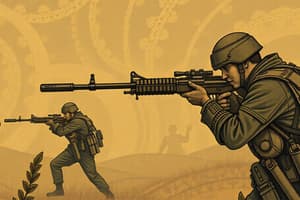Podcast
Questions and Answers
What does MIL typically refer to?
What does MIL typically refer to?
MIL typically refers to 'Military' or 'Military Influence.'
List the branches of the military.
List the branches of the military.
The branches of the military include Army, Navy, Air Force, Marine Corps, and Coast Guard.
What is the main focus of maneuver warfare?
What is the main focus of maneuver warfare?
Maneuver warfare focuses on movement and positioning.
Name a type of military operation that aims to protect territory.
Name a type of military operation that aims to protect territory.
What are the phases of military operations?
What are the phases of military operations?
What do the Geneva Conventions establish?
What do the Geneva Conventions establish?
How does military service impact cultural identity in some societies?
How does military service impact cultural identity in some societies?
What is asymmetric warfare?
What is asymmetric warfare?
What advancement in technology is significant in modern military applications?
What advancement in technology is significant in modern military applications?
What is one impact of defense spending on the economy?
What is one impact of defense spending on the economy?
Flashcards are hidden until you start studying
Study Notes
MIL Overview
- Definition: MIL typically refers to "Military" or "Military Influence," which encompasses various aspects related to military forces, operations, strategies, and their impact on society and politics.
Military Structure
-
Branches of the Military:
- Army
- Navy
- Air Force
- Marine Corps
- Coast Guard (in some countries)
-
Command Structure:
- Hierarchical organization from soldiers to generals.
- Unified Combatant Commands for joint operations.
Military Operations
-
Types of Operations:
- Offensive: Aimed at defeating or neutralizing the enemy.
- Defensive: Protecting and holding territory or resources.
- Stability Operations: Maintaining or re-establishing order.
-
Phases of Military Operations:
- Planning
- Execution
- Assessment
Military Strategy
-
Key Concepts:
- Maneuver Warfare: Focus on movement and positioning.
- Attrition Warfare: Wearing down the enemy over time.
- Asymmetric Warfare: Use of unconventional tactics by weaker opponents.
-
Strategic Objectives:
- National security
- Deterrence
- Power projection
Military Influence on Society
-
Cultural Impact:
- Military service as a rite of passage in some cultures.
- Influence on national identity and pride.
-
Economic Impact:
- Defense spending and its effects on the economy.
- Military contracts and job creation in the defense sector.
Military Ethics and Law
-
Rules of Engagement:
- Regulations governing how military personnel should conduct operations.
-
International Law:
- Geneva Conventions: Standards for humanitarian treatment in war.
- Laws of Armed Conflict: Guidelines for the conduct of war.
Modern Military Trends
-
Technological Advancements:
- Drones and unmanned systems.
- Cyber warfare capabilities.
- Artificial Intelligence in military applications.
-
Globalization of Military Influence:
- Increased cooperation between nations (alliances like NATO).
- Rising concerns over militarism in politics and governance.
Conclusion
- The military plays a critical role in national defense, international relations, and societal development, with a complex interplay of strategy, ethics, and technology shaping its influence.
MIL Overview
- Meaning of MIL: Refers to "Military" or "Military Influence," encompassing military operations, strategies, and societal impacts.
Military Structure
-
Branches of the Military:
- Includes Army, Navy, Air Force, Marine Corps, and Coast Guard (in certain nations).
-
Command Structure:
- Features a hierarchical system from enlisted soldiers to high-ranking generals, ensuring organized leadership.
- Utilizes Unified Combatant Commands for coordinated joint military operations.
Military Operations
-
Types of Operations:
- Offensive: Targeted actions to defeat or neutralize adversaries.
- Defensive: Efforts focused on protecting territory or resources.
- Stability Operations: Aimed at maintaining or restoring order in unstable regions.
-
Phases of Military Operations:
- Planning: Developing strategies and logistics before action.
- Execution: Carrying out military actions on the ground.
- Assessment: Evaluating the effectiveness of operations after execution.
Military Strategy
-
Key Concepts:
- Maneuver Warfare: Prioritizes movement and positioning for tactical advantage.
- Attrition Warfare: Involves weakening the enemy through continuous losses over time.
- Asymmetric Warfare: Smaller, weaker forces using unconventional tactics against stronger opponents.
-
Strategic Objectives:
- Focuses on national security, deterrence of adversaries, and projecting power globally.
Military Influence on Society
-
Cultural Impact:
- Military service can serve as an important rite of passage and is integral to national identity and pride in various cultures.
-
Economic Impact:
- Defense spending significantly influences national economies.
- Creation of jobs linked to military contracts fuels the defense sector.
Military Ethics and Law
-
Rules of Engagement:
- Set of regulations dictating acceptable conduct during military operations.
-
International Law:
- Geneva Conventions: Establish humanitarian standards during conflict.
- Laws of Armed Conflict: Provide guidelines for ethical warfare.
Modern Military Trends
-
Technological Advancements:
- Increased use of drones, unmanned systems, and cyber warfare capabilities.
- Integration of artificial intelligence into military strategies.
-
Globalization of Military Influence:
- Enhanced international cooperation through alliances such as NATO.
- Escalating concerns regarding military influence in political and governance contexts.
Conclusion
- The military significantly shapes national defense, international relations, and societal evolution, with ongoing dynamics in strategy, ethics, and technological integration influencing its role.
Studying That Suits You
Use AI to generate personalized quizzes and flashcards to suit your learning preferences.




